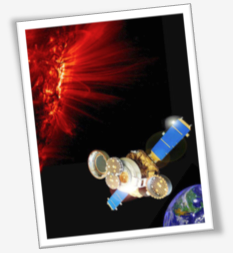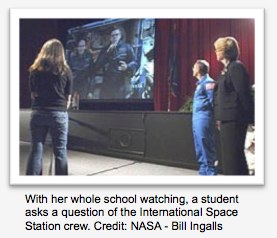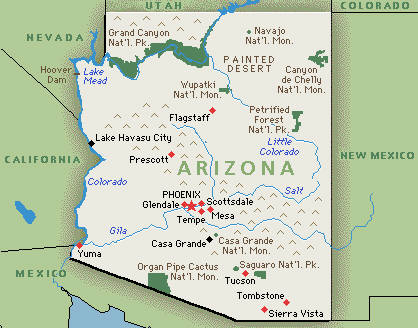NASA’s Endeavor Science Teaching Certificate Project awards 12-18-month fellowships each year to 50 formal educators. Cohort 4 begins in January 2012. NASA Endeavor Fellows take five online graduate courses in an innovative, live format from the comfort of their homes or schools. In these courses, participants gain science, technology, engineering and mathematics professional development and mastery of STEM pedagogical strategies. They learn to apply these strategies and cutting-edge STEM content to their classroom contexts while becoming part of a network of like-minded educators across the nation.
Endeavor Fellows earn and are awarded a NASA Endeavor Certificate in STEM Education from Teachers College, Columbia University. Fifteen graduate credits are awarded from regionally accredited higher education partners.
Collaborating with the National Board for Professional Teaching Standards, Endeavor has arranged for an option whereby fellows may put their work from the STEM certificate toward becoming nationally board certified in mathematics or science.
Applications for Cohort 4 will be accepted through Oct. 31, 2011.
 Analysis from NASA’s Genesis mission indicates our sun and its inner planets may have formed differently than previously believed.
Analysis from NASA’s Genesis mission indicates our sun and its inner planets may have formed differently than previously believed. Analysis from NASA’s Genesis mission indicates our sun and its inner planets may have formed differently than previously believed.
Analysis from NASA’s Genesis mission indicates our sun and its inner planets may have formed differently than previously believed.
 During Expeditions 31 and 32, crew members aboard the International Space Station will participate in downlinks. Downlinks are approximately 20 minutes in length and allow students and educators to interact with astronauts through a question and answer session. Downlinks afford education audiences the opportunity to learn firsthand from astronauts what it is like to live and work in space. Downlinks are broadcast live on NASA TV and are streamed on the NASA website. Because of the nature of human spaceflight, organizations must demonstrate the flexibility to accommodate changes in downlink dates and times.
During Expeditions 31 and 32, crew members aboard the International Space Station will participate in downlinks. Downlinks are approximately 20 minutes in length and allow students and educators to interact with astronauts through a question and answer session. Downlinks afford education audiences the opportunity to learn firsthand from astronauts what it is like to live and work in space. Downlinks are broadcast live on NASA TV and are streamed on the NASA website. Because of the nature of human spaceflight, organizations must demonstrate the flexibility to accommodate changes in downlink dates and times.
 In this NASA Now episode, Dr. Ed Ethridge, a ceramics engineer at Marshall Space Flight Center in Huntsville, Ala.,explains his research on extracting water from lunar soil, or lunar regolith.
In this NASA Now episode, Dr. Ed Ethridge, a ceramics engineer at Marshall Space Flight Center in Huntsville, Ala.,explains his research on extracting water from lunar soil, or lunar regolith. After only six months in orbit around Mercury, NASA’s MESSENGER spacecraft is sending back information revolutionizing the way scientists think about the innermost planet. Analysis of data from the spacecraft shows, among other things, evidence of widespread flood volcanism; the first close-up views of Mercury’s “hollows”; the first direct measurements of the chemical composition of Mercury’s surface; and the first global inventory of plasma ions within Mercury’s space environment.
After only six months in orbit around Mercury, NASA’s MESSENGER spacecraft is sending back information revolutionizing the way scientists think about the innermost planet. Analysis of data from the spacecraft shows, among other things, evidence of widespread flood volcanism; the first close-up views of Mercury’s “hollows”; the first direct measurements of the chemical composition of Mercury’s surface; and the first global inventory of plasma ions within Mercury’s space environment. Earth is about to pass through a stream of debris from Halley’s comet, source of the annual Orionid meteor shower. Forecasters expect more than 15 meteors per hour to fly across the sky on Saturday morning, Oct. 22, when the shower peaks.
Earth is about to pass through a stream of debris from Halley’s comet, source of the annual Orionid meteor shower. Forecasters expect more than 15 meteors per hour to fly across the sky on Saturday morning, Oct. 22, when the shower peaks. NASA Explorer Schools educator Kaci Heins and students from Arizona participated in a lesson based on the Mars Student Imaging Project. Her students studied geographic features on Earth and then used NASA photos to learn more about geographic features on Mars. Students applied skills such as measurement and how to document observations as well as reinforcing their understanding of latitude and longitude.
NASA Explorer Schools educator Kaci Heins and students from Arizona participated in a lesson based on the Mars Student Imaging Project. Her students studied geographic features on Earth and then used NASA photos to learn more about geographic features on Mars. Students applied skills such as measurement and how to document observations as well as reinforcing their understanding of latitude and longitude. Learn about sonic booms and the speed of sound from aerospace engineer George Hatcher as he shares his excitement of physics in his description of how the space shuttles reentered Earth’s atmosphere. This program available on the NES Virtual Campus beginning Oct. 17, 2011.
Learn about sonic booms and the speed of sound from aerospace engineer George Hatcher as he shares his excitement of physics in his description of how the space shuttles reentered Earth’s atmosphere. This program available on the NES Virtual Campus beginning Oct. 17, 2011. Baltimore’s Maryland Science Center is going to be the “landing site” for the full-scale model of NASA’s James Webb Space Telescope, and it’s free for all to see.
Baltimore’s Maryland Science Center is going to be the “landing site” for the full-scale model of NASA’s James Webb Space Telescope, and it’s free for all to see.